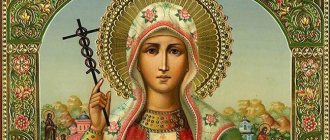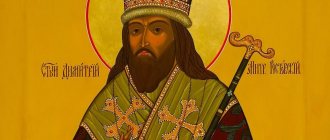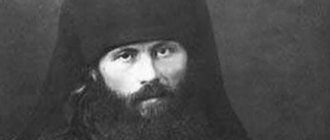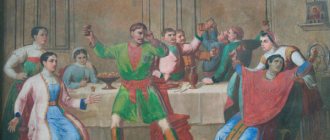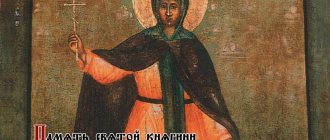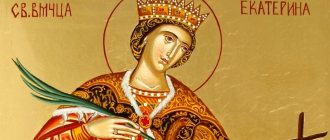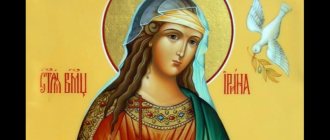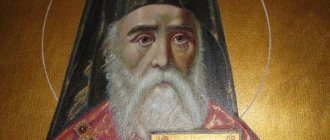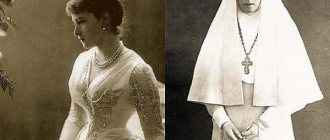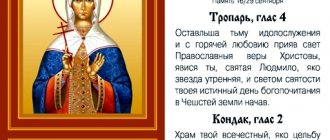Symbol of faith
The Creed is a statement of faith of an Orthodox person, his agreement with all the events that occurred more than 2000 years ago.
This prayer should especially be read in moments of despair, in moments of doubt, since by its affirmation it destroys these doubts. If there is doubt in even one line of the prayer, then something is wrong with faith. “I believe, Lord! Help my unbelief!
Christians set out their confession of faith in the Creed.
The Creed is a prayer book that contains all the basic provisions and dogmas of the Orthodox Church. This doctrine is stated in the Creed in a brief but very precise form. It was compiled in the 4th century by the fathers of the First and Second Ecumenical Councils.
https://www.youtube.com/watch?v=channelUC6Ytm9zOjwb2dZdN2hN_LiA
It is universal, and is suitable both for everyday reading (during morning prayers) and for special occasions, for example on the day of baptism of children (boys or girls). The creed is not a prayer (but a confession of faith). For it does not contain appeals to God, the Most Holy Theotokos, Angels or saints.
“Creed” in Russian with accents
I believe in one God, the Father Almighty, Creator of heaven and earth, everything visible and invisible.
And in one Lord Jesus Christ, the Son of God, the only begotten, begotten of the Father before all ages, Light from Light, true God from true God, begotten, not made, one being with the Father, through whom all things were created;
for us people and for our salvation, he came down from heaven, took flesh from the Holy Spirit and the Virgin Mary and became human,
crucified for us under Pontius Pilate, suffered and buried,
resurrected on the third day according to the Scriptures,
ascended into heaven and sits at the right hand of the Father,
and He will come again with glory to judge the living and the dead; His kingdom will have no end.
And in the Holy Spirit, the Lord, the giver of life, who proceeds from the Father, worshiped and glorified equally with the Father and the Son, who spoke through the prophets.
And into the one, Holy, Universal and Apostolic Church.
I confess one baptism for the remission of sins.
I await the resurrection of the dead
and the life to come. Amen.
The 1st member talks about God the Father, the 2nd to 7th members talk about God the Son, the 8th – about God the Holy Spirit, the 9th – about the Church, the 10th – about baptism, the 11th and 12th -th - about the resurrection of the dead and eternal life.
| 1st. I believe in one God, the Father, Almighty, Creator of heaven and earth, visible to all and invisible. | I believe in one God, the Father, Almighty, Creator of heaven and earth, of everything visible and invisible. |
| 2nd. And in one Lord Jesus Christ, the Son of God, the only begotten, who was born of the Father before all ages; Light from Light, true God from true God, begotten, uncreated, consubstantial with the Father, by whom all things were; | (I believe) in one Lord Jesus Christ, the Only Begotten Son of God, begotten of the Father before all ages; Light from Light, true God from true God, begotten, not created, one being with the Father, through whom all things were created; |
| 3rd. For our sake, man and our salvation came down from heaven, and became incarnate from the Holy Spirit and the Virgin Mary, and became human; | For us people and for our salvation, He came down from heaven, took flesh from the Holy Spirit and the Virgin Mary, and became human; |
| 4th. Crucified for us under Pontius Pilate, and suffered and was buried; | Crucified for us under Pontius Pilate, suffered and buried; |
| 5th. And he rose again on the third day, according to the Scriptures; | And rose again on the third day, according to the Scriptures (prophetic). |
| 6th. And ascended into heaven, and sits at the right hand of the Father; | And ascended into heaven and sat at the right hand of the Father; |
| 7th. And again the one who is to come will judge with glory the living and the dead, His Kingdom will have no end. | And again he will come with glory to judge the living and the dead, a kingdom that will have no end. |
| 8th. And in the Holy Spirit, the Lord, the Life-Giving One, who proceeds from the Father, who is with the Father and the Son, worshiped and glorified, who spoke the prophets. | (I believe) also in the Holy Spirit, the Lord, the giver of life, who proceeds from the Father, worshiped and glorified equally with the Father and the Son, who spoke through the prophets. |
| 9th. Into the One, Holy, Catholic and Apostolic Church. | (I believe) in the One, Holy, Catholic (Ecumenical) and Apostolic Church. |
| 10th. I confess one Baptism for the remission of sins. | I confess one Baptism for the remission of sins. |
| 11th. I hope for the resurrection of the dead. | I look forward to the resurrection of the dead. |
| 12th. And the life of the next century. Amen. | And the life of the next century. Truly so. |
* There is no letter е in the Church Slavonic language, therefore all е must be read as е (not ё).
The miraculous appearance of a saint in Ryazan
Tradition says that on that day the residents of Ryazan attended an evening service, the deacon, coming out in the middle of the church, unexpectedly called everyone to the banks of the Oka to meet the bishop. The surprised people appeared near the river just at the moment when the archpastor appeared, standing on a mantle that floated on its own against the current. Joyful exclamations were heard far around, the prince of Ryazan came out to meet the saint with crosses.
Icon of St. Basil of Ryazan
The care of the flock did not last long; as a result of the raids of the Tatars, Ryazan and its churches were burned; in 1288, the saint sailed on his mantle to Pereyaslavl, stopping at the Boris and Glebov Church.
The Church of the Holy Passion-Bearers Princes Boris and Gleb became a cathedral church under the new bishopric, where Father Vasily ruled until 1295.
Test of Faith
The people of Murom could not believe in the immaculate holiness and purity of the saint, seeing how a barefoot girl often came out of the bishop's chambers. It was the devil who took on the guise of a girl in order to dishonor the saint, and people believed in what they themselves saw. Residents of the city, led by the boyars, came to the priest’s house and demanded that he give an answer, accusing him of riotous living and adultery.
We advise you to study Prayers before Communion
Until recently, people admired the spiritual purity of the priest, but here they were ready to commit lynching without fear of God. Without taking into account either the old age of the priest or his merits, they decided to expel the slandered and desecrated saint from Murom. Father Vasily did not make excuses, but humbly asked to give him time until the morning. The anointed one of God prayed throughout the night in the Boris and Gleb Church; in the morning, in the Annunciation Church, a Divine Liturgy took place in front of the bright image of the Mother of God.
Having prayed, the Monk Basil the Wonderworker entrusted himself into the hands of a just God, took the bright face of the Mother of God and went to the Oka River. In front of a huge crowd of people, the persecuted priest took off his robe and covered the river surface with it, stood on a thin cloth cover, holding the icon of the Mother of God in front of him, and began to move against the flow of the river.
Interesting! The repentant and ashamed residents of Murom fell to their knees before the miracle revealed, with which the Lord Himself defended the honor of His anointed one, and before the people could blink an eye, Saint Basil was transferred to Ryazan.
This is interesting: Saint Theophylact of Bulgaria
Life of Saint Basil of Ryazan
Saint Basil, as the fourth bishop of Ryazan, is mentioned in the Laurentian Chronicle. Unfortunately, little is known about him: the first description of his life was compiled only in the 16th century by the monk Ermolai, a famous publicist.
It is known that Vasily Ryazansky took monastic vows in Murom, and there, after some time, he was ordained a bishop. According to the biography, Prince Georgy Yaroslavovich took part in this.
After some time, residents accused the bishop of shameful and unworthy behavior: many saw a barefoot and half-naked girl enter his chambers. It was the devil himself, who decided to undermine people's faith in the bishop. Embittered people demanded that Vasily be executed, but he asked to be given until 3 o’clock in the morning.
Vasily Ryazansky spent the whole night in prayer, performed an all-night vigil, served a liturgy and a prayer service before the miraculous icon of the Mother of God. Then at 9 o’clock in the morning he went out to the Oka River and spread the bishop’s robe on the water. Then he stood on the cloth, holding the icon of the Mother of God in his hands, and floated as if on a raft to Old Ryazan, the capital of the principality of the same name. He was in Ryazan already at 3 o’clock in the afternoon, just in time for Vespers, although the distance between the cities is more than 200 km.
A legend has been preserved that the Ryazan priest, officiating the service, could not begin it. He was silent until the Lord enlightened him. The priest predicted that the righteous Bishop Vasily, whom they should honor, would soon come to them.
The department was also moved to the city, and when it was destroyed, it moved to Pereyaslavl Ryazan (modern Ryazan). A perfect miracle was often depicted on icons.
The saint was loved and revered by the laity. His memorial days are June 23 and July 16.
Icon “Healer”: what it helps with, meaning
Many people eventually begin to say something similar: the main thing is health. Only everyone understands this statement in their own way. Sometimes it takes a serious illness to turn to the Lord, and sometimes the Lord heals His children by showing mercy.
The famous icon of the Mother of God “Healer” is associated specifically with healing from illnesses. The very history of this image tells how a miracle appeared in this world.
Numerous further miraculous works that are performed in a holy manner to this day help believers and strengthen the Orthodox.
From the history of icons
The first mention of the healing icon of the Most Holy Theotokos “Healer” is found in chronicles dating back to approximately the 4th century, to the time of Equal-to-the-Apostles Nina.
The icon was preserved in one of the oldest churches, but now it is unknown what exactly the plot was described there. However, there is a more modern image that is now also considered canonical.
It is based on a legend in which healing is welcomed; it is described in detail in the work of Demetrius of Rostov “Irrigated Fleece”.
So, more modern history dates back to the 18th century, when a certain Vikenty Bulveninsky lived in Moscow, who was not particularly interested in how the icon of the Mother of God “Healer” helped, but always actively prayed in front of this image when he was in the temple. Nevertheless, Vincent suffered from a serious illness and all he could do was stay in bed and suffer from various pains. Vincent did not deviate from his faith and continued to pray to the Mother of God whenever he found such an opportunity and was a little freed from pain.
Doctors did not consider it possible to cure this clergyman. He simply continued his prayer and then the Mother of God appeared to him right next to the bed, the figure emitting light. Vincent was eventually healed and immediately went to the temple to offer prayers there; at his command, an icon of the Mother of God “Healer” was created, which describes the plot of a miraculous healing.
How does the “healer” icon help?
More often than others, the holy image of the “Healer” can be seen in temples and churches near hospitals.
This is done so that people who are overtaken by illness can turn to the Mother of God with a request to give strength and heal body and soul. This is the meaning of the icon.
A clear example of this is the most famous of the churches of the Old Catherine Hospital in Moscow, which is illuminated in honor of the healing Blessed Virgin Mary and the parish at the hospital of Alexander III. Unfortunately, these buildings have not survived to this day.
During the Bolshevik era, they ceased to exist and were rebuilt.
But currently they are trying to revive the old tradition of praying to the Mother of God in front of the “Healer” icon and placing the image in churches near hospitals.
So in 1992, in the name of the “Healer,” the newest church at the hospital of the Research Institute of Clinical Psychiatry in Moscow was consecrated.
Now, as before, everyone who needs the help of the Most Holy Theotokos can always ask her for it, the Benefactor will not leave anyone in trouble.
Also, if you look at where the “Healer” icon is located in Moscow, then you should note the temple in Sokolniki, the Resurrection of Christ. This is where the revered image is located. There are modern testimonies of healings that are recorded even today; prayer in front of this image provides healing from various ailments and helps believers.
In times of hardship, one should turn to this image with pure thoughts and sincerely in order to receive healing and help.
In addition, many prefer to turn to this holy face at the beginning and during any treatment and, if possible, in order to maintain health and faith in the Lord.
Troparion of the Mother of God before the icon of Her Healer
voice 1
To Love, Pure Virgin, Your holy icon to those who venerate/ and the true Mother of God to those who glorify/ and faithfully worship/ the Healer who appears,/ removing all evil and disease from these,/ like the Almighty.
Troparion of the Mother of God before the icon of Her Healer
voice 4
Like the Most Bright Star, asking Your holy image for Divine miracles, Healer, grant us, Mother of God Mary, healing of mental and physical ailments, salvation and great mercy.
We advise you to study Prayers for adult children
Kontakion of the Mother of God before the icon of Her Healer
voice 6
The intercession of Christians is not shameful, the intercession to the Creator is immutable, do not despise the voices of sinful prayers, but advance, as the Good One, to the aid of us who faithfully call Thee: hasten to prayer, and strive to entreaty, ever interceding, the Mother of God, who honor Thee.
Location of the relics of St. Basil of Ryazan
After the death of the saint, he was buried in the Ryazan Boris and Gleb Cathedral. At first, his remains were located inside the temple, but due to perestroika, they ended up outside its walls. Local residents did not forget about the saint and took care of his icon. At the beginning of the 17th century, in the midst of troubled times, fearing the destruction of the shrine, Archbishop Theodoret made a lot of efforts to protect it.
The discovery of the incorruptible relics took place on June 20, 1609. They were transferred to the Assumption (Nativity of Christ) Cathedral and placed in the left choir under a bushel. At the same time, the kontakion and troparion were written. In Soviet times, believers saved them from ruin, and in the early 90s they returned them to the temple.
But the miraculous icon that the bishop brought with him disappeared. Only a few copies remained of it, which until recently were also considered lost. In 2002, one was miraculously found, which is located in the Assumption Cathedral in the summer, and in the Nativity of Christ in the winter.
Ikos 4
Those who were at enmity with you in the city of Murom heard your very meek words, O saint of Christ, in your image you asked to give you a little time until morning until the third hour, taming your rage and going to your homes; You, servant of God, after your all-night tearful prayer to God the Savior and the Most Pure Mother of God in the church of the holy passion-bearers Boris and Gleb, having received in your hands the honorable icon of the Mother of God, you went to the river Otsa, although you would leave the city of Murom and sail along the waves. Remembering this departure of yours, we exclaim to you: Rejoice, high image of wondrous humility; Rejoice, bright mirror of firm faith and unshakable hope in the Most High God. Rejoice, pillar of patience, unshakable by human malice; Rejoice, adamante, indestructible to the enemies. Rejoice, kindly lamb, through your meekness you tamed your persecutors like wondrous beasts; Rejoice, by your humility you have gloriously put to shame the machinations of the devil. Rejoice, blessed peacemaker, having escaped from worldly unrest and rebellion; Rejoice, having given yourself over to the waves of the river with faith and trust in the Lord. Rejoice, Vasily, High Hierarch of Ryazan and wonderful miracle worker!
Error in the text, broken link?
Pleasant of God, Vasily Ryazansky
lived in the second half of the thirteenth century.
No evidence has been preserved about his origin - from whom and where he was born. But there are indications in church hymns that Saint Basil of Ryazan
was a sanctified servant of the Lord from his infancy, that from his youth he perfected himself both morally and spiritually, conquering the sinful in himself through the fear of God and planting everything holy in his soul and heart.
He began his first deeds of piety in Murom. There he took upon himself the holy image of a monk, and when God’s Providence was pleased to make him a hierarch of the Murom-Ryazan flock, he already shone with great feats of abstinence, meekness and humility. About the election of St. Vasily to the rank of bishop, his life says this: “After the desolation of the city of Murom from infidel people, the noble prince Georgy Yaroslavich arrived from Kyiv to Murom. This prince renovated the local Church of the Annunciation and the second church of St. passion-bearers Boris and Gleb and installed in their church, as before, a bishop named Vasily, a righteous and pious man.”
Having assumed the high rank of bishop, Saint Basil of Ryazan, with all the zeal of a true shepherd of the Church of Christ, began to work in building up his flock: he gathered those scattered by the barbarian invasion into one flock, strengthened the weak with faith, consoled the brokenhearted with firm hope in the mercy of God, returned the lost to the right path. In such high deeds of virtue, Saint Basil showed himself to be a good shepherd, wise and vigilant, merciful and loving, gentle and humble, an unshakable pillar of purity and chastity, an example to his flock in prayers, fastings, and in the deeds of the patrists.
Such lofty exploits and virtues of the saint became unbearable to the enemy of all good things - the devil. He uses all his satanic tricks to arouse suspicion in the frivolous people of Murom about the purity and chastity of the life of the Holy Hierarch. He takes on the appearance of a prodigal maiden, often enters and leaves the saint’s dwelling, shows himself to the people from the saint’s window and, apparently, succeeds in his machinations. One day, the boyars and people gathered to visit St. Basil in the evening and saw a girl running up the steps to the saint, boots in her hands. That's what the devil did. The people, seeing this, cried out: “Oh, bishop, it is unworthy for you to have virgins on your bed in your temple.” In vain did Saint Basil assure the people: “I am innocent of this prodigal deed that you tell me.” The people, in self-forgetfulness, began lynching the saint of God: they were not afraid of his holiness, they were not ashamed of the splendor of his honest gray hair, they slandered him, cursed him and decided to expel the saint from Murom. There were even those who shouted in their fury: “We will kill him for this!” Then Saint Basil began to ask: “Fathers and brothers! Give me a little time, until three o’clock in the afternoon.” The people, struck by the meekness of the saint, agreed and went home. The innocent righteous man prayed all night with tears in the cathedral church of Boris and Gleb; I celebrated the all-night vigil and the Liturgy in the morning. Then he sang a prayer service before the icon of the Mother of God he revered in the Church of the Annunciation, took this icon with him and, surrendering himself to the will of God, with hope in the Mother of God, went to the Oka River to leave Murom forever. The people prepared a boat for him. But Saint Basil took off his mantle, spread it across the water, climbed onto it with the image of the Mother of God and, miraculously carried by the power of God, like a stormy wind, quickly swam along the river against the flow of its water. The mantle became a light ship for him, the Providence of God and the intercession of the Mother of God became the helm. Struck by the miracle, the residents of Murom, everyone, from old to young, cried out with tears: “Oh, holy Vladyka Vasily! Forgive us, your sinful servants; “I have sinned before you, Father, Holy Master, do not forget us, your servants.” But Saint Basil was taken from the eyes of the Murom people “in the blink of an eye.” Thus God justified the innocence of His righteous man before the people. Thus He put to shame the machinations of the devil, who sought the destruction of the people.
After mass, at 3 o'clock in the afternoon, Saint Vasily of Ryazan left Murom, and at 9 o'clock of the same day (for Vespers) he was brought to Ryazan (old), a distance of more than two hundred miles from Murom. The wondrous Providence of God miraculously notified the residents of Ryazan that St. Basil was approaching their city. Tradition says that the residents of Ryazan, just before the arrival of the saint, gathered in the church for the evening service, but the deacon in vestments, who came out to begin the service, with all his efforts could not pronounce the usual beginning. The people looked at this with amazement. Finally, the deacon, as if released from the bonds that bound his lips, involuntarily proclaimed: “I cannot begin, the Master has arrived, meet the Master!” And the entire cathedral of shepherds with holy crosses, the prince with the boyars and the people hastened to go to the shore of the Oka to meet the revealed saint and, seeing him floating on a mantle with the Most Pure Image of the Mother of God, received him with great joy.
But the joy of Saint Basil and his flock did not last long. It was a time of sorrow, not joy. During one devastating barbarian raid, Ryazan with all its churches was destroyed, and the Providence of God assigned Saint Basil of Ryazan another place of refuge and rest - this is present-day Ryazan. Tradition says that St. Vasily sailed here along the Oka and Trubezh on his miraculous mantle with the same Murom image of the Mother of God to the Church of Boris and Gleb. Here he founded a new bishopric and the Church of Boris and Gleb from that time became a cathedral.
The pastoral ministry of Saint Basil lasted only ten years. The griefs, labors and worries he endured, sorrows and sorrows at the sight of his flock suffering under the yoke of the Tatars, shortened the saint’s arduous life, and on July 3 (old style), 1295, Saint Basil moved to the eternal monasteries. His holy body was buried in the Boriso-Gleb Cathedral.
It was not without the good purposes of God's Providence that Saint Basil of Ryazan moved from one place to another. It enlightened the people of Murom, revealing to them the machinations of the devil, and the inhabitants of Ryazan and Pereyaslavl Ryazan - some it consoled and strengthened in their most sorrowful time, and for others it gave an example of faith and patience.
To strengthen and console the believers in a terrible time for our Fatherland, the time of impostors and the Polish invasion, God’s Providence was pleased to glorify His saint by the incorruption of his relics, which had rested in the ground for more than three hundred years. The holy relics of St. Basil were discovered by Archbishop Theodoret of Ryazan and transferred with due honor to the Assumption (now Nativity of Christ) Cathedral. This happened on June 10, 1609. Due to the troubled times, they were placed under cover, on the left choir.
In 1636, a stone tomb was built over the relics of the saint, and the icon of the Mother of God “The Prayer of Basil” was placed above it. In 1753, this tomb was remade like a shrine with the image of St. Vasily, and in 1783 decorated by the Reverend Simon.
At the place where St. relics of St. Vasily of Ryazan, at the Boris-Gleb Cathedral, in 1712, instead of an ancient linen tent, a stone tent was built, and in 1834, the ktitor of the Boris-Gleb Cathedral, Semyon Panov - “by secret inspiration to him from above” - erected a cast-iron monument.
0
What Orthodox prayers you need to know by heart
Hello! What prayers a Christian needs to know and why this question worries every person who begins to attend church. The same question arises when we have problems in life. This article will tell you everything you need to know about prayers.
Four Important Prayers
There are many praises in the prayer books. Morning prayer is important, as well as “for every need” before meals. Many believers read them according to the prayer book. But there are prayers that must be recited by heart.
- Our Father.
- Publican's prayer: “God, be merciful to me, a sinner.”
- Doxology to the Most Holy Trinity. “Glory to the Father, and the Son, and the Holy Spirit, now and ever, and unto ages of ages.” Amen.
- Doxology to the Virgin Mary.
When turning to the Savior, you should say the Jesus Prayer daily:
The Jesus Prayer must be said when leaving the house, going to bed and at any other time.
Church-speaking pronunciation takes us back to the origins of ancestral memory, which was laid in the heart for centuries. This language instills humility and a special attitude towards our Orthodox history.
If you don’t know how to do the doxology at home, then say the prayer of St. Philaret, which gives consolation to the suffering soul.
How to learn prayers
All Orthodox Christians need to know some of the prayers by heart. Knowing them, you will no longer repeat the words: “Lord, help me,” without remembering God, but simply the first thing that comes to mind.
But many complain that it can be difficult to memorize them. It's sad, but fixable. Ask God's blessing to memorize words. First, read them according to the prayer book. Gradually the holy words will be deposited in memory.
When can you say prayers? The three main ones should be read in any situation when you need to ask God for help, but you don’t know how to find the right words. One of the prayers will facilitate any of your requests.
- Jesus gave the “Our Father” to his disciples who asked him to teach him how to pray. The Almighty allowed people to call him Father, and He proclaimed the entire human race to be His sons. By saying prayer words, Christians find salvation and gain God's grace.
- "Symbol of faith" . Christians believe that Jesus Christ was incarnated in human form, then appeared to the world, was crucified in the name of delivering people from the burden of original sin, and on the third day was resurrected as a symbol of victory over death.
- Prayer to the Lord Jesus. Turning to Jesus Christ as the Son of God, people do not demand proof, but simply believe in the true God, asking for help or protection from the Almighty.
Whatever happens, Praise the name of the Lord for every deed, everything is given by God. Thank Him that you see the sky, the sun, that you have the opportunity to live another bright, joyful day. Every day should be lived in joy, because the Lord gave it to you. And having asked for something from the Almighty, do not forget to thank your quick helper for everything that happened, for everything you have in life, even for the smallest thing.
Important prayers for believers
Knowing the most important prayer services, we must not forget that there are other Orthodox prayers. Reading them, you will find peace, you will immediately see how life will not be as difficult as you thought before. And all this is thanks to the fact that you have a quick helper and intercessor from all hardships - this is our Lord God.
Prayer to the Most Holy Trinity.
Each person at baptism is given the name of a Guardian Angel. Do not forget to turn to him in any troubles and needs. He will definitely hear, he will definitely help. Don't forget to thank him even for the smallest things.
We advise you to study Prayers from Thieves
Prayer to the Guardian Angel.
Make a daily petition for the living, at home in front of an icon, or in a church.
Every family has deceased relatives. Not all Christians know how to pray for their soul. A simple prayer for the departed will help.
Before praying, you must say: Lord Jesus Christ, Son of God, prayers for the sake of Your Most Pure Mother and all the saints, have mercy on us. Amen.
And the words: “Glory to Thee, our God, glory to Thee” must be said after the Publican’s prayer, and also before the beginning of all the others. These few words set a Christian up for a conversation with God. Write down the words on a piece of paper so you don’t forget to say them before praying. Then learn it by heart.
Finally: what prayers should you know? This question no longer faces you; over time, you will study many doxologies, because they contain great love for God, a great desire to love, believe, repent and forgive.
Source
What do they ask the saint for?
The Ryazan saint is approached in various difficult situations. He is known as the patron of the offended and oppressed, a wise adviser and defender of the disadvantaged.
In prayers they turn to him with the following problems:
- About guiding those who are lost and cannot find the path of faith on the true path.
- About calmness and peace, about strengthening faith and peace of mind.
- About perseverance in overcoming life's adversities.
- About getting rid of bad thoughts and stress.
- About getting support in a difficult situation, about help in making a difficult decision.
- About wisdom and patience, which will be useful in the fight against evil and injustice.
Also, travelers often turn to the saint for protection, especially those who travel by water.
Prayer
Prayer to Saint Basil of Ryazan Saint Father Vasily! By your wondrous procession through the waters and the incorruption of your honorable relics, having become convinced that you have received great grace from the Lord God, we run to you with faith and hope and tenderly pray to you: pray for us, Christ our God, who saved you, like Peter, from drowning in the waves of the river and from decay in the heart of the earth, may His saving grace accompany us on all the paths of this life, keeping us unharmed from every evil situation, quenching every nasty wind of adversity and storm of passions, while giving us quiet and serene sailing in this worldly life. May the Merciful Lord forgive us every sin, voluntary and involuntary, covering the weakness of our nature with His goodness, may He confirm us in His holy Orthodox faith and piety, filling our hearts with love and zeal for keeping His commandments for the salvation of our souls. May she grant peace and prosperity to the Orthodox Russian Church, may she speak good things in the hearts of our rulers about her and about all people, may she bring down times of peace on our land, may the air be well-dissolved, the earth be fruitful and all that is needed for the benefit of this life, and may she deliver all the cities and towns our fatherland and the entire Russian land from famine, destructive fire, deadly plagues and from all evil, so that in peace, prosperity and success in virtues, having passed this path of life, we will enter the eternal kingdom prepared for His saints. O all-praised saint and servant of Christ, Vasily! We believe and hope that with your prayers you can arrange all the good things for our souls and bodies, having our Most Blessed Lady Theotokos as our Helper, even as we preserve the honorable and miraculous icon, the procession on the waters, as on dry land, having completed, you have reached the God-saved city of Ryazan. For this reason, we diligently pray to you: do not turn us away from your intercession, strive for our help and pray for us to the Lord and our God Jesus Christ, who delivered you from the evil snares of the evil one and human slander, and, having looked upon us mercifully, will deliver us from all troubles , sorrows and illnesses of soul and body, and may He vouchsafe us, sinners and unworthy, His Heavenly Kingdom with the prayers of His Most Holy Mother and your warm intercession for us, always, now, and ever, and forever and ever. Amen.
Iconography
The earliest image of St. Basil of Ryazan is known on the icon “Constantine, Michael and Theodore in the Life” from the Murom church in honor of the Annunciation of the Blessed Virgin Mary, painted in 1714 by the Murom icon painter Alexander Kazantsev (now in the MIHM). 14 of the 87 marks of the icon (from 74 to 87) tell about the saint.
The basis for the independent images of the saint was the miracle of the Murom Icon of the Mother of God included in the plot of the Tale of Vasily of Ryazan, which is connected with the history of the expulsion of the bishop from Murom. The saint is depicted full-length in a three-quarter spread, floating along the river on a mantle spread out on the water, with an icon of the Mother of God in his right hand and with a staff in his left hand (icons: 1918, MIHM; mid-19th century, work by artist N.V. Shumov , RIAMZ; XX century, chapel in the name of St. Basil in the Boris and Gleb Cathedral of Ryazan). In memory of this miracle, which took place through the prayer of the slandered bishop, the icon received a second name - “Prayer of St. Vasily."
The icon shows the 1st floor. XIX century (RIAMZ) Saint Basil is presented against the background of a landscape frontally in full-length, in hierarchal vestments, his hands are spread to the sides - with his right he blesses, in his left the Gospel.
In the “Cathedral of Murom Saints” St. Basil is depicted together with the saints Prince. Constantine and his children Michael and Theodore, Peter and Fevronia, Juliania Lazarevskaya in the 3rd row from the left on the 18th century icon. (MIHM). A cycle of miniatures from the beginning of the century has been preserved. to the Tale of Vasily Ryazansky [12], made on paper of the 17th century. I. G. Blinov and was considered until the end of the 1980s. ancient manuscript [13].
In the summary iconographic original of Filimonov (XVIII century), under April 15, the appearance of the saint is said: “In the likeness of the gray haired braid of Basil of Caesarea, in short, the robe of the saint, crimson, blue underwear, in an omophorion, in the hand is the Gospel, and the other is blessed, on the head is a hat saintly."
A similar description of the image of the saint on April 15 or January 28 is placed in the Stroganov [14], Peretsevsky [15] originals, in a manuscript from the collection. RNB [16] and others.
Where are the relics of St. Basil and the temple dedicated to him
For more than 300 years, his burial place remained inviolable. However, during this time, the church property acquired a different shape, and the grave ended up outside the temple. During the Time of Troubles, preserving an Orthodox shrine from destruction becomes a matter of honor. Through the labors and prayers of Archbishop Theodoret, the incorrupt relics of the saint were transferred to the Assumption Cathedral of the Ryazan Kremlin. It became a solemn event.
3 centuries after the death of the holy elder, his image, by the will of God, again became a stronghold for strengthening faith and uplifting the human spirit. The transferred relics were buried in a crypt, in a hidden place, to avoid desecration of the revered shrine.
Today the temple is called the Nativity of Christ. The composition of the troparion and kontakion for the saint dates back to this same time. For more than four centuries, since the discovery and transfer of the saint’s incorruptible relics, they have rested at the northern wall of the Nativity Cathedral. Part of them, left for reverent veneration, is located in a special ark above the burial site.
At the beginning of the 20th century, during the period of persecution of the church, they were saved from ruin through the efforts of believers and several decades later they were again transferred to the Ryazan church. Above the burial place of the elder is the Murom Icon of the Mother of God.
Temple address: Russia, Ryazan, Kremlin street, 13
Meaning and veneration in Orthodoxy
Vasily Ryazansky spent his entire life righteously and peacefully, trying to help people and instruct them on the path of faith. He often talked with parishioners and gave them advice in difficult life situations. Thanks to his kindness, meekness and humility, he enjoyed the love of people both during his life and after death. It is no coincidence that after almost 3 centuries, they did not want to leave his relics outside the walls of the temple, fearing that enemies would abuse them.
Today he is the patron saint of Ryazan, to whom local residents often turn in prayer. He is also considered the patron saint of travelers, especially sailors and those who move on water.
But what he is best known for is the test of faith. Slandered, standing in front of an angry crowd, he did not blindly make excuses and beg for mercy. Believing in the justice of the Lord and his intercession, Vasily boldly stepped on the bishop's mantle and swam, proving his innocence by a perfect miracle.
Literature
- PSRL. T. 18. St. Petersburg, 1913. S. 23, 83, 99, 120, 121;
- The Tale of Peter and Fevronia / Prepared by. texts and research. R. P. Dmitrieva. L., 1979. P. 325-326 [Crat. ed. monument];
- The story of the establishment of Christianity in Murom (according to the RKP. Rumyantsev Museum No. 364) // Monuments of ancient literature, ed. gr. G. Kushelev-Bezborodko. St. Petersburg, 1860. Issue. 1. pp. 229-240 [Space. ed.].
- Voice in defense of the tradition of Saint Basil I, bishop. Ryazan // CHOIDR. 1859. Book. 3. Dept. 1. P. 147-160;
- SISPRTS. pp. 49-51; Barsukov. Sources of hagiography. Stb. 92;
- Golubinsky. Canonization of saints. P. 122;
- Lives of the Saints. M., 1916. Book. add. 2nd. Jan.-Apr. pp. 571-572;
- Wagner G.K. The Tale of the Ryazan Bishop. Vasily and its significance for the early history of Pereyaslavl-Ryazan // TODRL. 1960. T. 16. P. 167-177 [Bibliography];
- Dmitrieva R. P. Two editions of the 16th century. Stories about the Ryazan bishop. Vasily // Cultural heritage of Ancient Rus': Origins, formation, traditions. M., 1976. S. 136-142;
- Dmitrieva R.P. The Tale of the Ryazan Bishop. Vasily: (History of the text, original ed.) // TODRL. 1977. T. 32. P. 40-55;
- The story of Peter and Fevronia. pp. 79-94.
- Podobedova O. I. Front manuscript of the 17th century. “Tales about the city of Murom and its bishopric...” // TODRL. 1960. T. 16. P. 374-387;
- Markelov. Saints Dr. Rus'. T. 2. P. 73-74;
- Sirotinskaya A. A. Iconography of St. Vasily Bishop Ryazan and Murom according to the materials of the Murom circle of monuments // Murom collection. Murom, 1993. Vol. 1. pp. 24-33.
